An Experimental Investigation into the Performance of Concrete and Mortar with Partial Replacement of Fine Aggregate by Printed Circuit Board (PCB) E-Waste
Abstract
1. Introduction
2. Results and Discussion
2.1. Composition of Pulverized PCB
2.2. Fresh Concrete Test (Slump Cone Test)
2.3. Mechanical Properties
2.3.1. Compressive Strength
2.3.2. Split Tensile Strength
2.3.3. Flexural Strength
2.3.4. Impact Strength
2.3.5. Bond Strength (Pull-Out Test)
2.3.6. Ultrasonic Pulse Velocity (UPV) Test
2.4. Durability Properties
2.4.1. Sulfate Attack Resistance
2.4.2. Water Absorption Test
2.5. Functional Properties
2.5.1. Acoustic Properties
2.5.2. Thermal Conductivity
2.5.3. Elevated Temperature Response
2.6. Microstructural Studies
3. Materials and Methods
3.1. Materials
3.2. Methods
4. Conclusions
- ➢
- Mechanical properties showed a noticeable improvement with increasing E-waste content up to 25 wt% for cement mortar and 20 wt% for concrete. When 25 wt% of PCB was used as replacement for fine aggregate, the mortar’s compressive and tensile strengths improved by 5.8%, while the strength of concrete samples increased by 3.1% for 20 wt% replacement, compared to the control mix. These enhancements are attributed to better matrix densification and the pozzolanic-like behavior of E-waste particles.
- ➢
- The durability properties were improved, especially the water absorption behavior. Compared to the control mixes, the modified mixes showed a 1.7% decrease in water absorption. This meant they were less likely to let water in and were able to endure in moisture-prone conditions.
- ➢
- However, excessive replacement beyond the optimal level led to inferior performance due to inadequate cement hydration. The dehydrated cement and broken C-S-H gel structures indicated this observation. These mixes exhibited higher permeability and lower strength characteristics due to the presence of a large number of pores and tiny cracks.
- ➢
- Functional properties such as acoustic and thermal insulation also showed improvements in the modified mixes. The improvement is primarily due to the low conductivity of PCB materials, as well as the increased porosity and heterogeneous internal structure introduced by the E-waste. These small pores in the material structure reduce the conduction of heat and sound vibrations, thereby elevating thermal and sound insulation. The thermal stability of PCB-incorporated concrete was found to match that of the control samples up to 400 °C, as ascertained from TGA.
Author Contributions
Funding
Data Availability Statement
Acknowledgments
Conflicts of Interest
References
- Danish, A.; Mosaberpanah, M.A.; Ozbakkaloglu, T.; Salim, M.U.; Khurshid, K.; Bayram, M.; Amran, M.; Fediuk, R.; Qader, D.N. A compendious review on the influence of e-waste aggregates on the properties of concrete. Case Stud. Constr. Mater. 2023, 18, e01740. [Google Scholar] [CrossRef]
- Needhidasan, S.; Sai, P. Demonstration on the limited substitution of coarse aggregate with the E-waste plastics in high strength concrete. Mater. Today Proc. 2020, 22, 1004–1009. [Google Scholar] [CrossRef]
- Manjunath, T.A. Partial Replacement of E-plastic Waste as Coarse-Aggregate in Concrete. Procedia Environ. Sci. 2016, 35, 731–739. [Google Scholar] [CrossRef]
- Borthakur, A.; Govind, M. Public understandings of E-waste and its disposal in urban India: From a review towards a conceptual framework. J. Clean. Prod. 2018, 172, 1053–1066. [Google Scholar] [CrossRef]
- Baldé, C.P.; Kuehr, R.; Yamamoto, T.; McDonald, R.; Althaf, S.; Bel, G.; Deubzer, O.; Fernandez-Cubillo, E.; Forti, V.; Gray, V.; et al. Global E-Waste Monitor 2024; International Telecommunication Union (ITU) and United Nations Institute for Training and Research (UNITAR): Geneva, Switzerland; Bonn, Germany, 2024. [Google Scholar]
- Dixit, S.; Arora, R.; Kumar, K.; Bansal, S.; Vatin, N.; Araszkiewicz, K.; Epifantsev, K. Replacing E-waste with coarse aggregate in architectural engineering and construction industry. Mater. Today Proc. 2022, 56, 2353–2358. [Google Scholar] [CrossRef]
- Kalpana, M.; Vijayan, D.S.; Benin, S.R. Performance study about ductility behavior in electronic waste concrete. Mater. Today Proc. 2020, 33, 1015–1020. [Google Scholar] [CrossRef]
- Pothinathan, S.K.M.; Kumar, P.; Arunachelam, N.; Gnanaraj, S.C. Effect of PCB as partial replacement of fine aggregate and coarse aggregate in concrete. Mater. Today Proc. 2022, 49, 2369–2373. [Google Scholar] [CrossRef]
- Shuqin, L.; Minyan, T.; Hongwei, T.; Xiaoyu, L.; Jian, G. Assessing sustainability on Chinese university campuses: Development of a campus sustainability evaluation system and its application with a case study. J. Build. Eng. 2019, 24, 100747. [Google Scholar] [CrossRef]
- Rajkumar, R.; Ganesh, V.N.; Mahesh, S.R.; Vishnuvardhan, K. Performance evaluation of E-waste and Jute Fibre reinforced concrete through partial replacement of Coarse Aggregates. Mater. Today Proc. 2020, 45, 6242–6246. [Google Scholar] [CrossRef]
- Janani, S.; Preethi, K.; Gowtham, S.; Kulanthaivel, P. A sustainable reuse of e waste as a partial replacement material for aggregate. Mater. Today Proc. 2023. [Google Scholar] [CrossRef]
- Panda, S.; Panigrahi, S.K. Production of sustainable GGBFS-based self-compacting geopolymer concrete containing e-waste aggregates under ambient temperature curing. Constr. Build. Mater. 2024, 440, 137373. [Google Scholar] [CrossRef]
- Ullah, Z.; Qureshi, M.I.; Ahmad, A.; Khan, S.U.; Javaid, M.F. An experimental study on the mechanical and durability properties assessment of E-waste concrete. J. Build. Eng. 2021, 38, 102177. [Google Scholar] [CrossRef]
- Sua-iam, G.; Chatveera, B. Effect of printed circuit board dust on the workability and mechanical properties of self-compacting concrete: A preliminary study. Constr. Build. Mater. 2014, 53, 611–618. [Google Scholar] [CrossRef]
- Manatkar, P.A.; Deshmukh, G.P. Use of non-metallic e-waste as a coarse aggregate in concrete. Int. J. Res. Eng. Technol. 2015, 4, 242–246. [Google Scholar]
- Han, M.; Li, J. Enhancement of Compressive Strength and Durability of Sulfate-Attacked Concrete. Buildings 2024, 14, 2187. [Google Scholar] [CrossRef]
- Sanyal, A.P.; Mohanty, S.; Sarkar, A. Application of Recycled Aggregates Generated from Waste Materials towards Improvement in Acoustical and Thermal Conductivity of Concrete. Mater. Today Proc. 2023. [Google Scholar] [CrossRef]
- Wang, Y.; Liu, H.; Zhao, Q.; Chen, G. Leaching behavior of heavy metals from PCB-embedded concrete matrices. Waste Manag. 2020, 118, 269–278. [Google Scholar] [CrossRef]
- Shah, S.; Houda, M.; Khan, S.; Althoey, F.; Abuhussain, M.; Abuhussain, M.A.; Javed, M.F. Mechanical behavior of E-waste aggregate concrete using a novel machine learning algorithm: Multi-expression programming (MEP). J. Mater. Res. Technol. 2023, 25, 5720–5740. [Google Scholar] [CrossRef]
- Ghanem, H.; Chahal, S.; Khatib, J.; Elkordi, A. Flexural behavior of concrete beams reinforced with recycled plastic mesh. Buildings 2022, 12, 2085. [Google Scholar] [CrossRef]
- Kumar, G.; Bansal, T.; Haq, M.; Sharma, U.; Kumar, A.; Jha, P.; Sharma, D.; Kamyab, H.; Valencia, E.A.V. Utilizing E-Waste as a Sustainable Aggregate in Concrete Production: A Review. Buildings 2024, 14, 2495. [Google Scholar] [CrossRef]
- Patel, N.; Balachandran, V. E-waste problems: An analysis. Int. J. Adv. Res. Manag. Soc. Sci. 2015, 4, 60–71. [Google Scholar]
- Sabrin, R.; Shahjalal, M.; Bachu, H.A.E.; Habib, M.M.L.; Jerin, T.; Billah, A.M. Recycling of different industrial wastes as a supplement of cement for sustainable production of mortar. J. Build. Eng. 2024, 86, 108765. [Google Scholar] [CrossRef]
- Panda, S.; Pradhan, M.; Panigrahi, S.K. Sustainable Self-Compacting Conventional Concrete Development with Optimal Content of Ladle Furnace Slag Concerning Mechanical and Durability Characteristics. Constr. Build. Mater. 2025, 471, 140761. [Google Scholar] [CrossRef]
- Wu, P.Y. Data-driven Approaches for Predicting Hazardous Substances in the Building Stock. Doctoral Thesis, Department of Building and Environmental Technology, Lund University, Lund, Sweden, 2024. [Google Scholar]
- Shi, D.; Xia, Y.; Wang, J.; Chen, F.; Ma, X.; Zhao, Y.; Liu, M.; Yu, K. Recycling E-waste CRT glass in Sustainable Geopolymer Concrete for Radiation Shielding Applications. J. Environ. Chem. Eng. 2024, 12, 114693. [Google Scholar] [CrossRef]
- Selvaraj, T.; Kaliyavaradhan, S.K.; Kakria, K.; Malladi, R.C. Use of e-waste in metakaolin-blended cement concrete for sustainable construction. Sustainability 2022, 14, 16661. [Google Scholar] [CrossRef]
- Muchhadiya, P.D.; Pitroda, J.R.; Gujar, R.; Soni, J. Multiple Regression Models for Compressive and Flexural Strength of Recycled Printed Circuit Board Concrete. Mater. Today Proc. 2022, 62, 6992–6997. [Google Scholar] [CrossRef]
- Priyan, M.V.; Ravella, D.P.; Alaneme, G.U. Transforming electronic waste into sustainable building materials for a cleaner environment: A review. Discov. Mater. 2024, 4, 100. [Google Scholar] [CrossRef]
- Menzie, C.A.; Southworth, B.; Stephenson, G.; Feisthauer, N. The Importance of Understanding the Chemical Form of a Metal in the Environment: The Case of Barium Sulfate (Barite). Hum. Ecol. Risk Assess. Int. J. 2008, 14, 974–991. [Google Scholar] [CrossRef]
- Almeshal, I.; Tayeh, B.A.; Alyousef, R.; Alabduljabbar, H.; Mohamed, A.M.; Alaskar, A. Use of Recycled Plastic as Fine Aggregate in Cementitious Composites: A Review. Constr. Build. Mater. 2020, 253, 119146. [Google Scholar] [CrossRef]
- Osei, D.Y. Experimental Investigation on Recycled Plastics as Aggregate in Concrete. Int J Struct Civ Eng Res 2014, 3, 168–174. [Google Scholar]
- Akinyele, J.O.; Ajede, A. The Use of Granulated Plastic Waste in Structural Concrete. Afr. J. Sci. Technol. Innov. Dev. 2018, 10, 169–175. [Google Scholar] [CrossRef]
- Mohan, H.T.; Jayanarayanan, K.; Mini, K.M. A Sustainable Approach for the Utilization of PPE Biomedical Waste in the Construction Sector. Eng. Sci. Technol. Int. J. 2022, 32, 101060. [Google Scholar] [CrossRef]
- Tafsirojjaman, T.; Dogar, A.U.R.; Liu, Y.; Manalo, A.; Thambiratnam, D.P. Performance and Design of Steel Structures Reinforced with FRP Composites: A State-of-the-Art Review. Eng. Fail. Anal. 2022, 138, 106371. [Google Scholar] [CrossRef]
- ASTM C1709-18; Standard Guide for Evaluation of Alternative Supplementary Cementitious Materials (ASCM) for Use in Concrete. ASTM International: West Conshohocken, PA, USA, 2023. [CrossRef]
- Kumar, P.K.; Kumaran, A.S.; Kandasamy, A.; Mohamed, M.J.S. Strength Characteristics of Concrete Using Electronic Plastic Waste and Coconut Shell as Natural Aggregates. Mater. Today Proc. 2022, 56, 2353–2358. [Google Scholar]
- Xie, J.; Li, J.; Lu, Z.; Li, Z.; Fang, C.; Huang, L.; Li, L. Combination Effects of Rubber and Silica Fume on the Fracture Behaviour of Steel-Fibre Recycled Aggregate Concrete. Constr. Build. Mater. 2019, 203, 164–173. [Google Scholar] [CrossRef]
- Espinosa, A.B.; Revilla-Cuesta, V.; Skaf, M.; Faleschini, F.; Ortega-López, V. Utility of Ultrasonic Pulse Velocity for Estimating the Overall Mechanical Behavior of Recycled Aggregate Self-Compacting Concrete. Appl. Sci. 2023, 13, 874. [Google Scholar] [CrossRef]
- Ambrose, E.; Ogirigbo, O.R.; Ekop, I.E. Compressive Strength and Resistance to Sodium Sulphate Attack of Concrete Incorporated with Fine Aggregate Recycled Ceramic Tiles. J. Appl. Sci. Environ. Manag. 2023, 27, 465–472. [Google Scholar] [CrossRef]
- IS 1124; Method of Test for Determination of Water Absorption, Apparent Specific Gravity and Porosity of Natural Building Stones. BIS: New Delhi, India, 1974.
- Palomar, I.; Barluenga, G.; Puentes, J. Lime–cement mortars for coating with improved thermal and acoustic performance. Build. Environ. 2012, 48, 239–245. [Google Scholar] [CrossRef]
- Park, S.; Pyo, S. Experimental Study on the Sound Absorption Performance of Surface-Perforated Mortar. Constr. Build. Mater. 2021, 307, 124824. [Google Scholar] [CrossRef]
- Al-Homoud, M.S. Performance characteristics and practical applications of common building thermal insulation materials. Build. Environ. 2005, 40, 353–366. [Google Scholar] [CrossRef]
- Ardhira, P.J.; Ardra, R.; Harika, M.; Sathyan, D. Study on Fibre Reinforced Foam Concrete-a Review. Mater. Today Proc. 2023. [Google Scholar] [CrossRef]
- Poon, C.-S.; Azhar, S.; Anson, M.; Wong, Y.-L. Comparison of the Strength and Durability Performance of Normal-and High-Strength Pozzolanic Concretes at Elevated Temperatures. Cem. Concr. Res. 2001, 31, 1291–1300. [Google Scholar] [CrossRef]
- Kodur, V.K.R. Performance-based fire resistance design of concrete structures. Nucl. Eng. Des. 2007, 237, 1999–2008. [Google Scholar] [CrossRef]
- Kavitha, S.S.; Madhavan, M.K.; Jayanarayanan, K.; Sarker, P.K. Axial Compressive Behavior of CFRP and MWCNT Incorporated GFRP Confined Concrete Cylinders After Exposure to Various Aggressive Environments. J. Compos. Sci. 2024, 8, 313. [Google Scholar] [CrossRef]
- IS 1489-1 (1991); Specification for Portland Pozzolana Cement, Part 1: Flyash Based. Bureau of Indian Standards: New Delhi, India, 1991.
- IS 383:1970; Specification for Coarse and Fine Aggregates from Natural Sources for Concrete. Bureau of Indian Standards: New Delhi, India, 1970.
- IS 2250:1981; Code of Practice for Preparation and Use of Masonry Mortars. Bureau of Indian Standards: New Delhi, India, 1981.
- IS 10262:2019; Code of Practice for Concrete Mix Proportioning. Bureau of Indian Standards: New Delhi, India, 2019.
- IS: 4031 (6); Methods of Physical Tests for Hydraulic Cement. Part 6: Determination of Compressive Strength of Hydraulic Cement Other than Masonry Cement. Bureau of Indian Standards: New Delhi, India, 1989.
- IS 516 (Part 1/Sec 1); 2021 Method of Tests for Strength of Concrete. Indian Standard: New Delhi, India, 2002.
- IS 516 (Part 5/Sec 1); 2018—Hardened Concrete—Methods of Test—Part 5 Non-Destructive Testing of Concrete—Section 1 Ultrasonic Pulse Velocity. Bureau of Indian Standards: New Delhi, India, 2018.
- ASTM C1012; Standard Test Method for Length Change of Hydraulic-Cement Mortars Exposed to a Sulfate Solution. ASTM International: West Conshohocken, PA, USA, 2024.
- ASTM C177-19; Standard Test Method for Steady-State Heat Flux Measurements and Thermal Transmission Properties by Means of the Guarded-Hot-Plate. ASTM International: West Conshohocken, PA, USA, 2009.
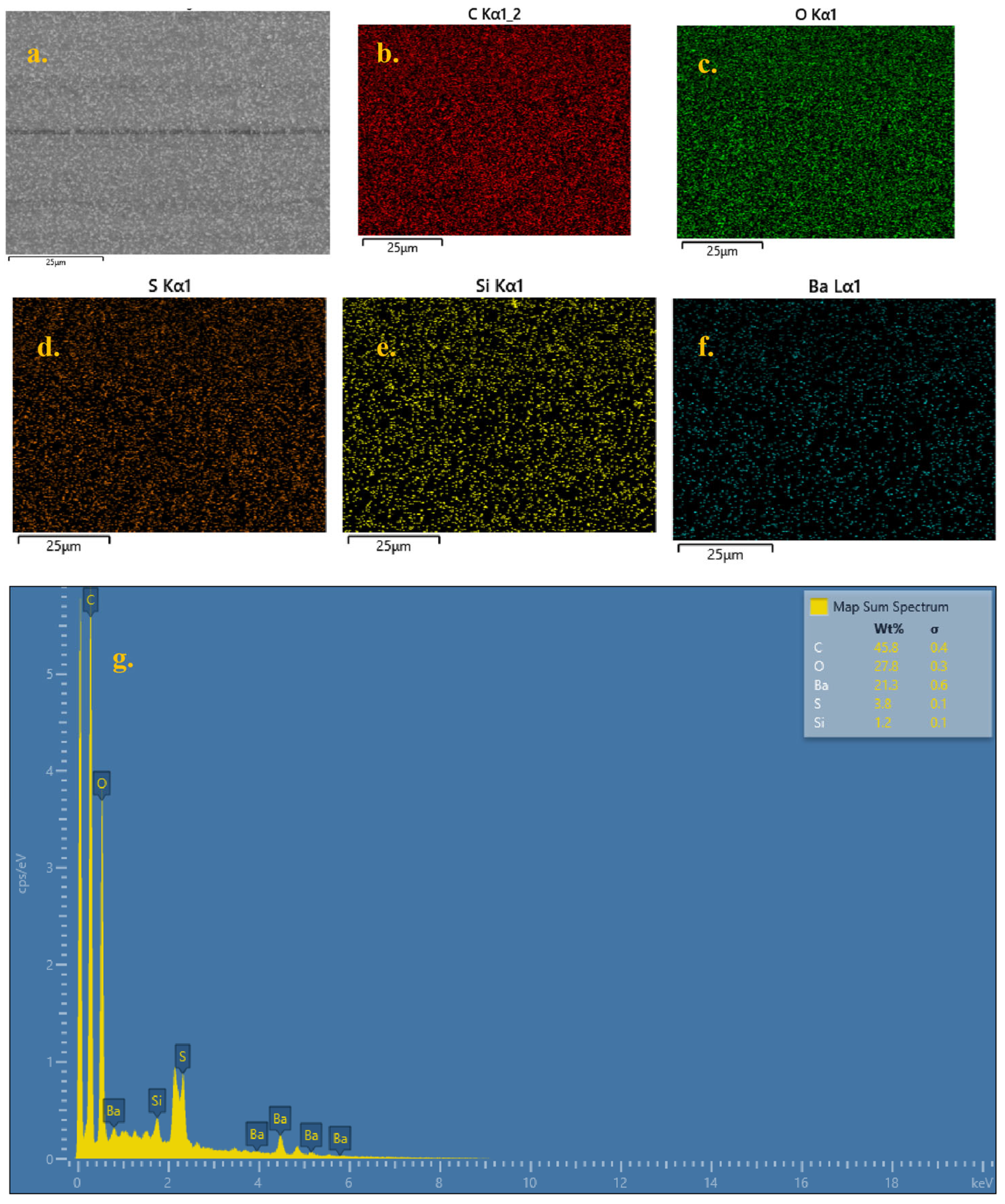
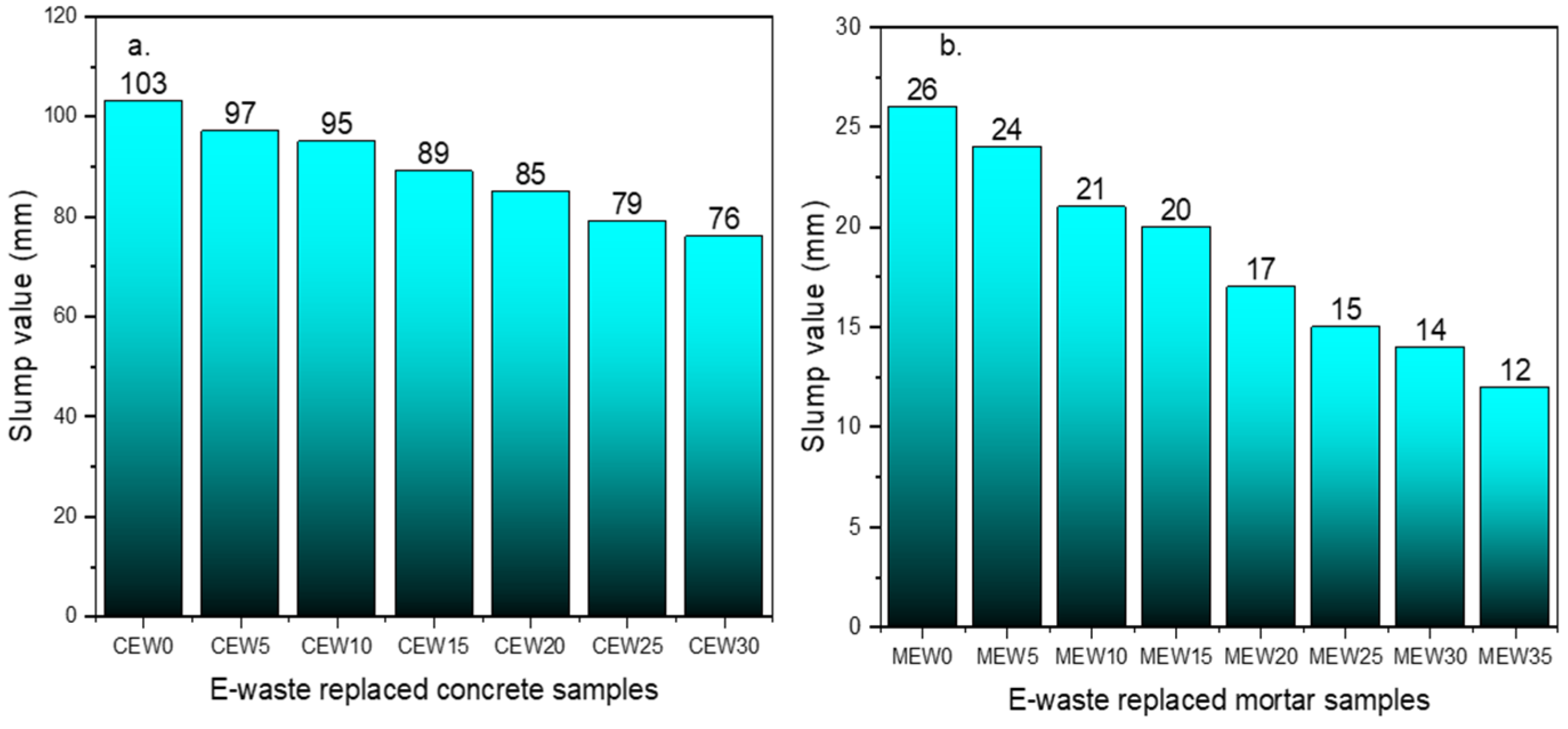


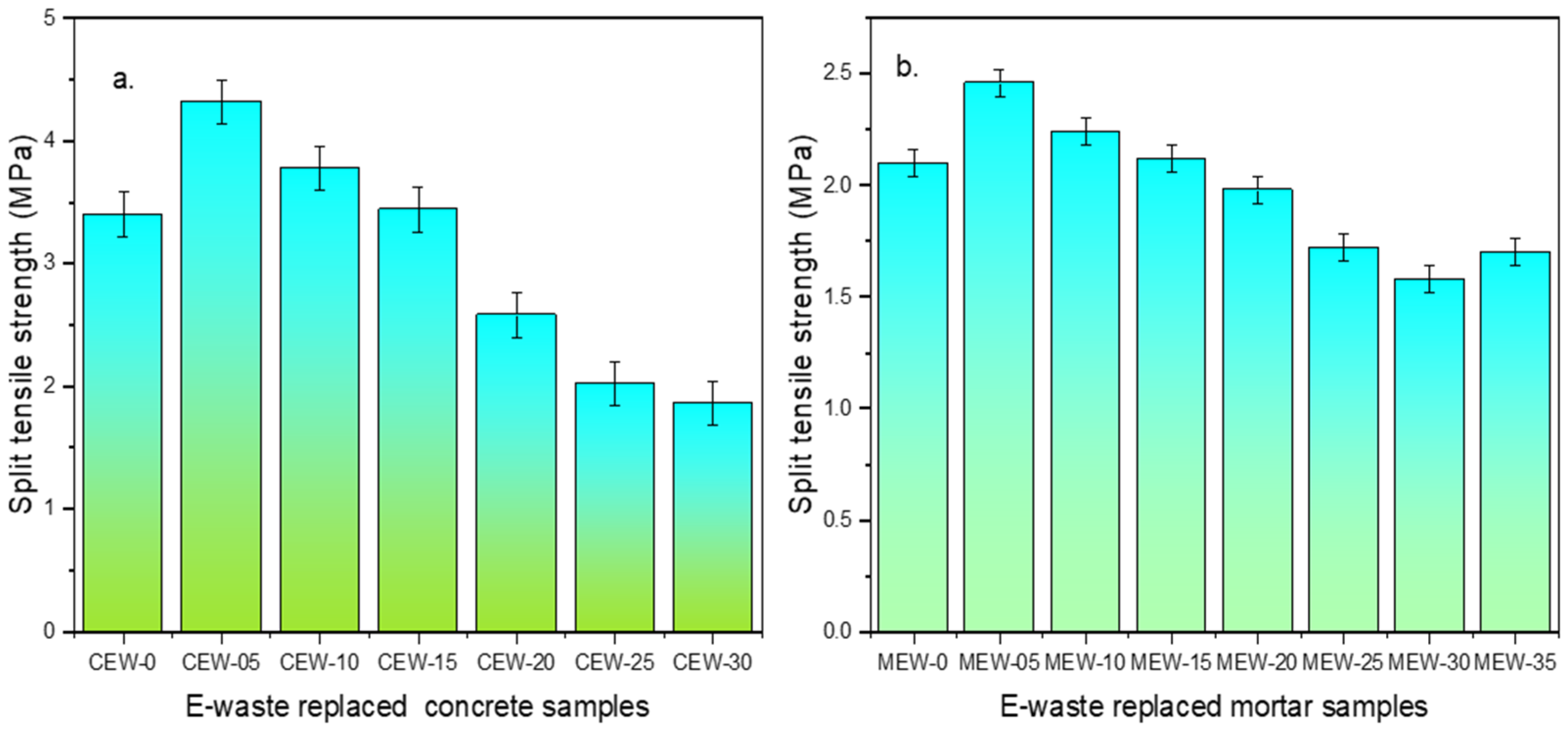
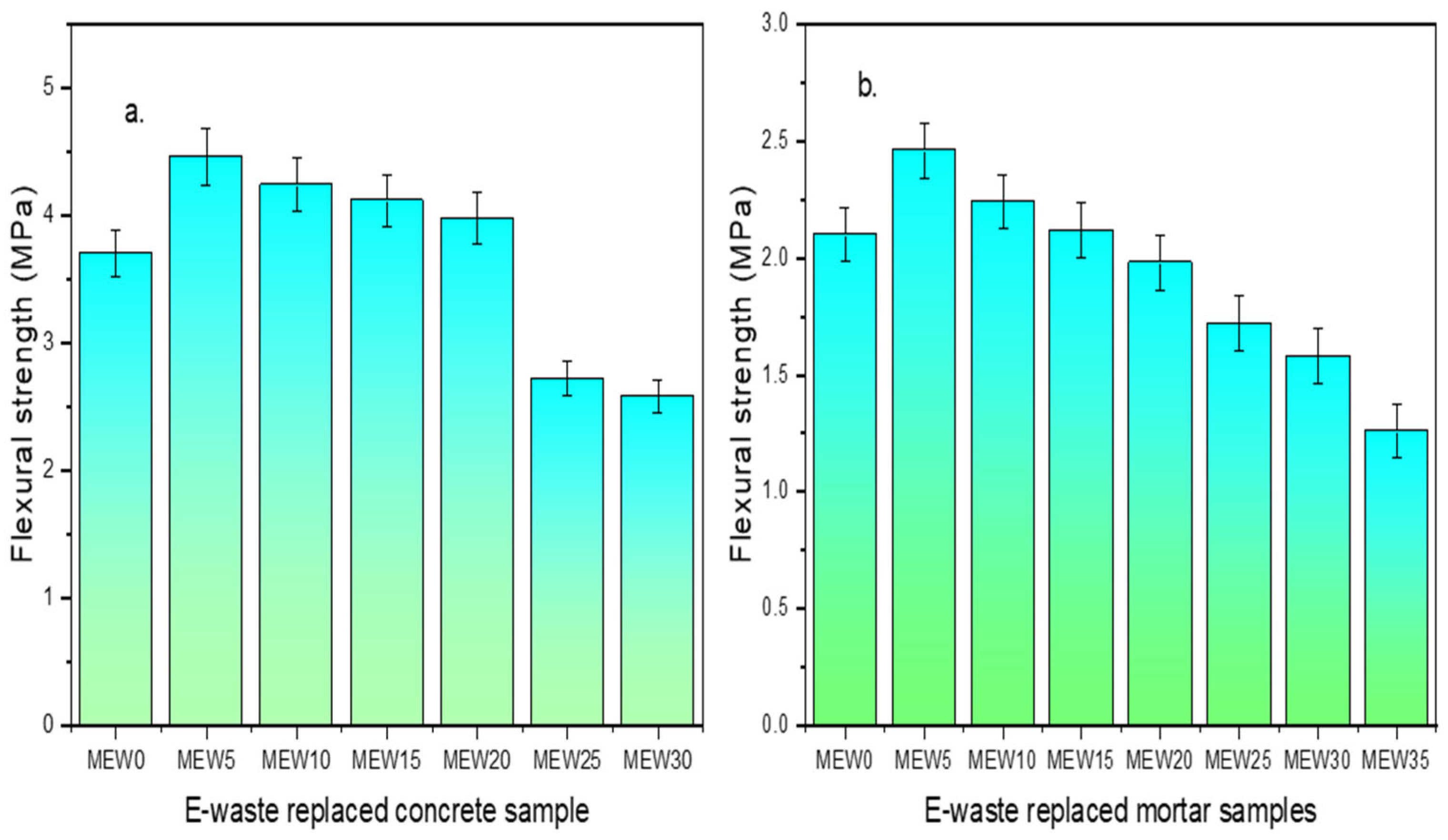
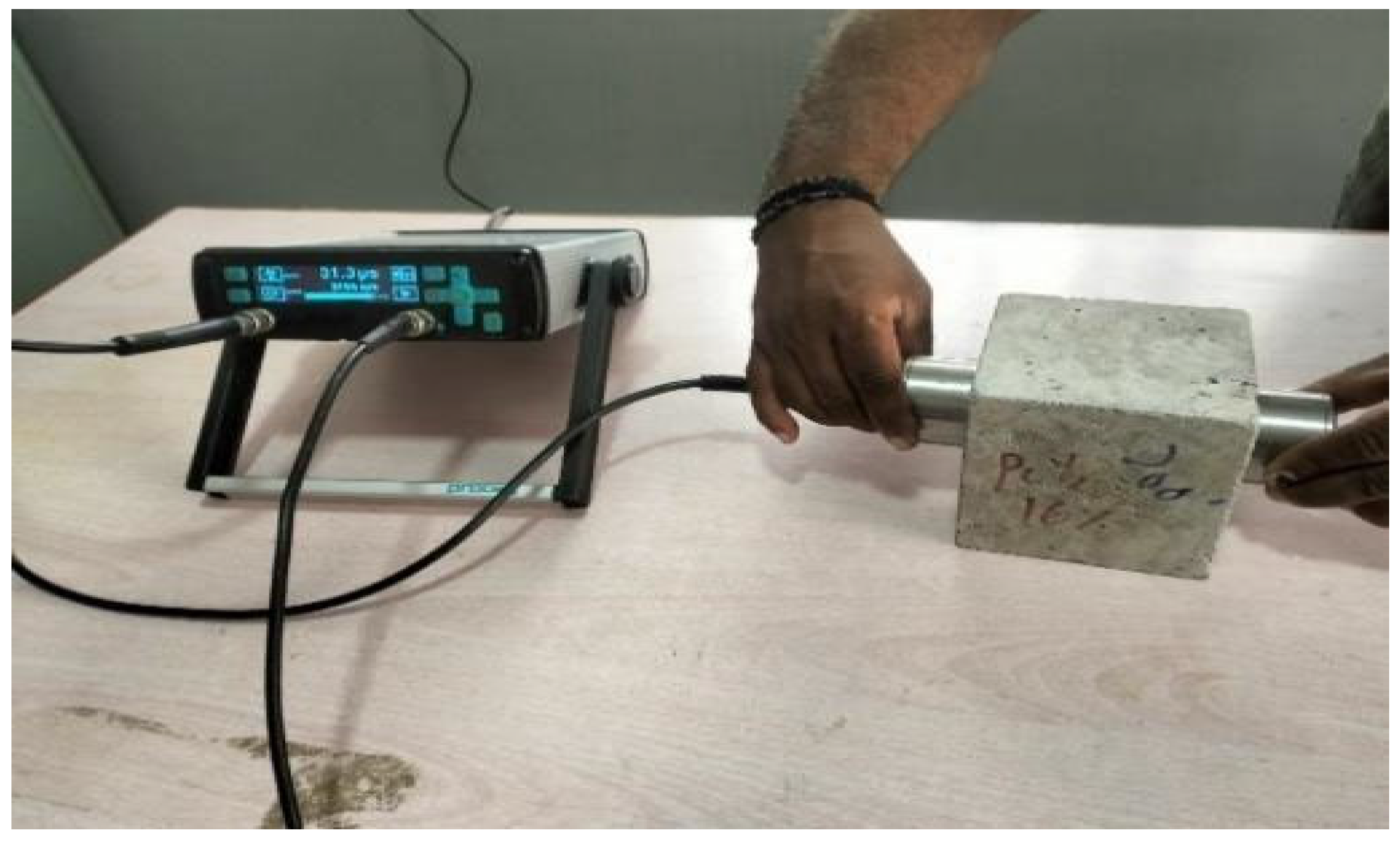
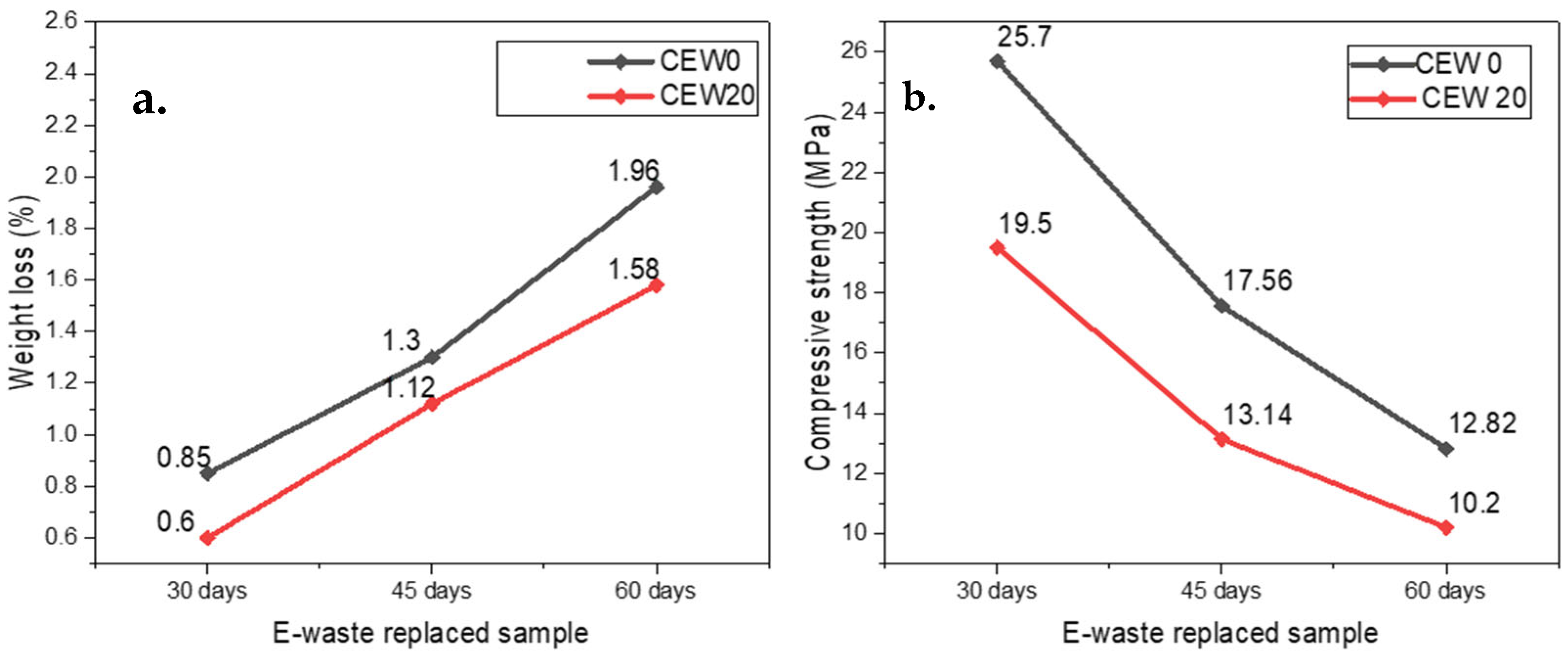
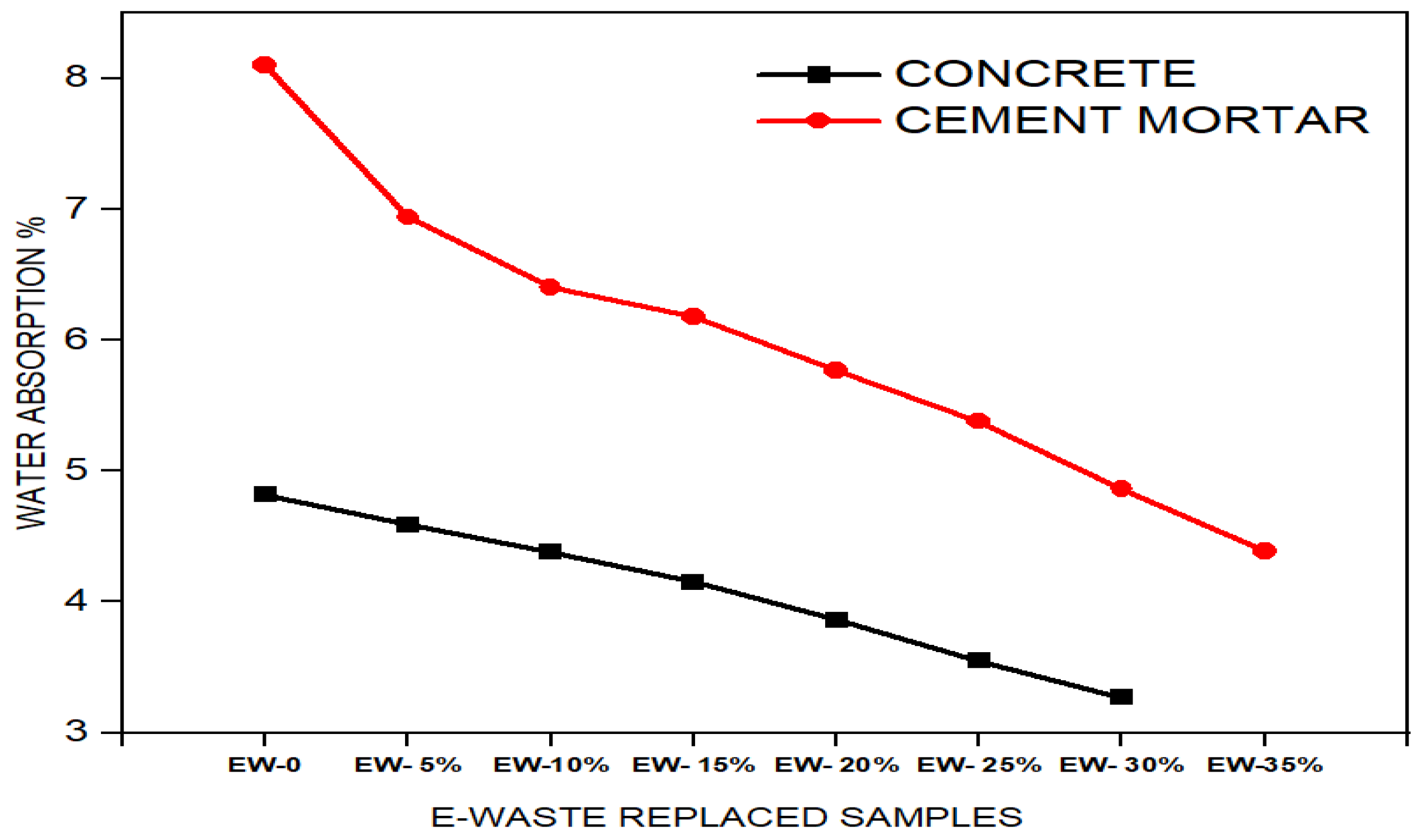

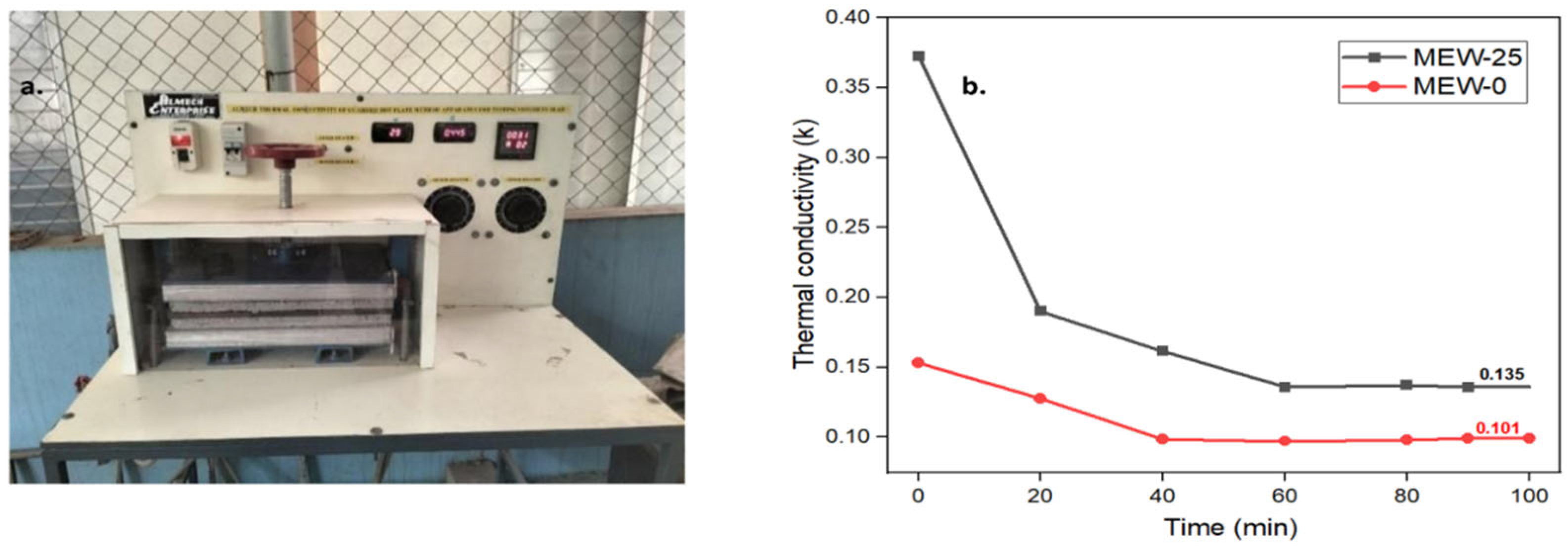

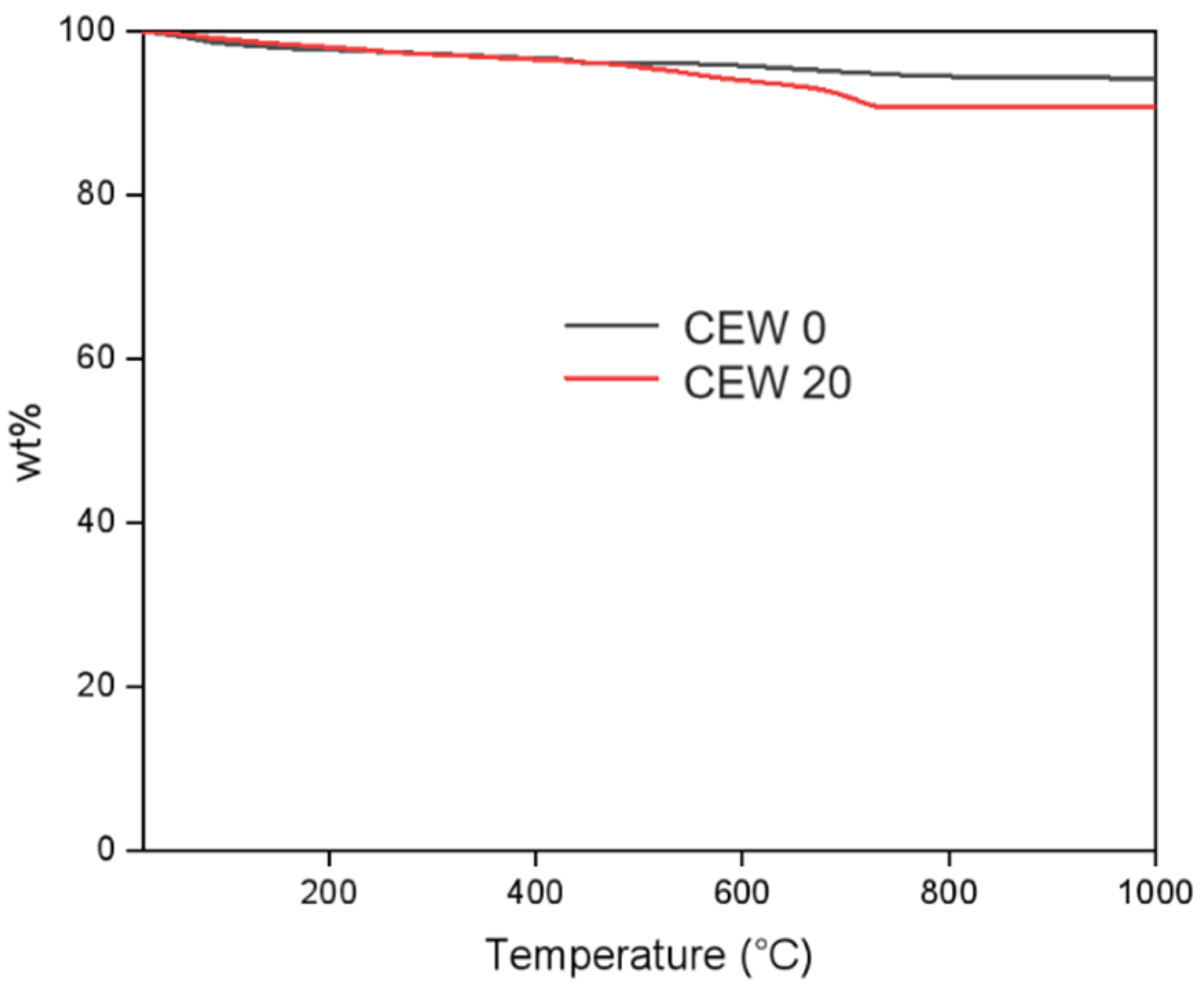


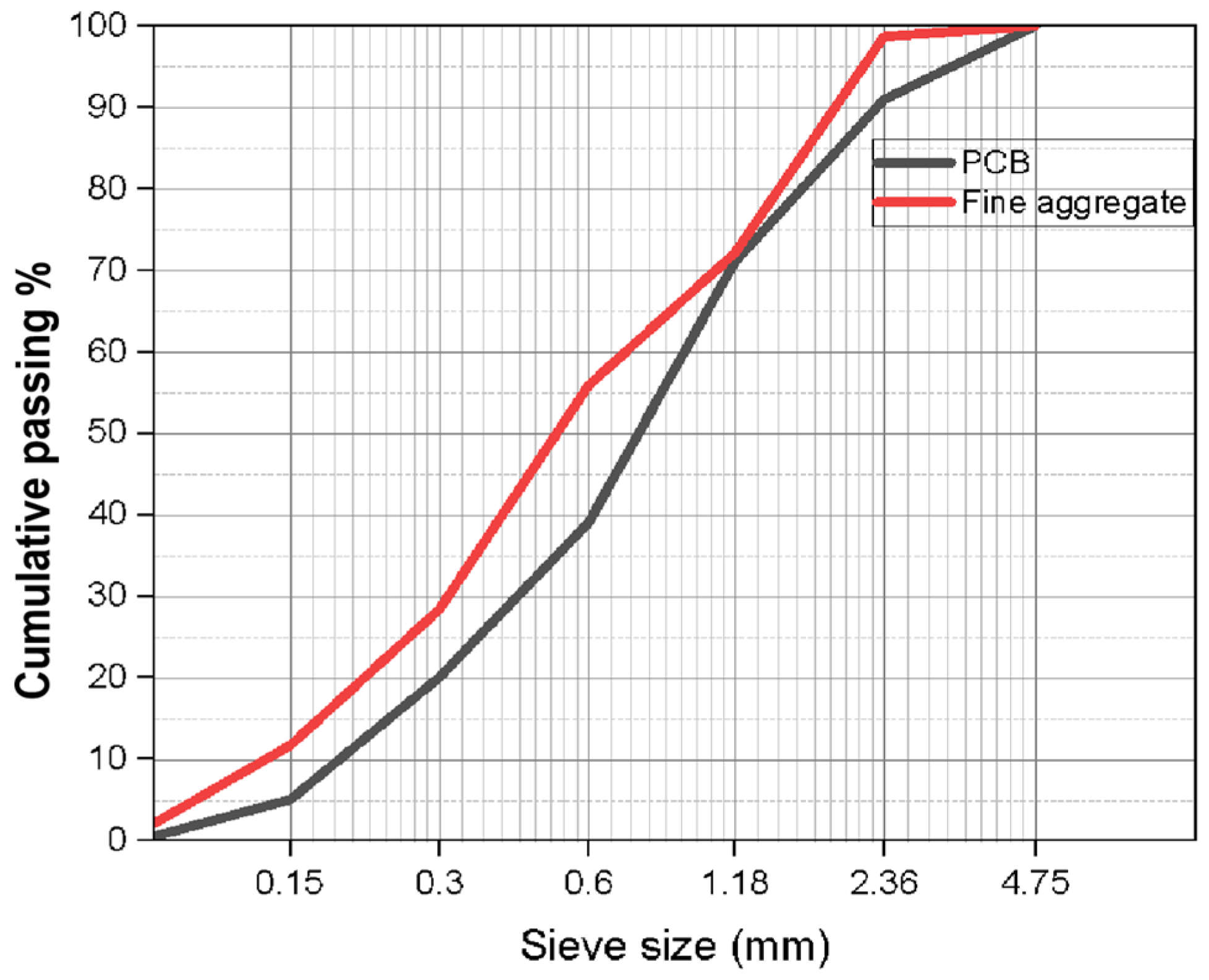
| S. No | Sample ID | Impact Strength of Cement Mortar (J) | Sample ID | Impact Strength of Concrete (J) |
|---|---|---|---|---|
| 1 | CEW0 | 1161 ± 0.30 | MEW0 | 387 ± 0.26 |
| 2 | CEW20 | 1609 ± 0.24 | MEW25 | 488 ± 0.44 |
| 3 | CEW25 | 835 ± 0.47 | MEW35 | 326 ± 0.38 |
| Properties | Cement | Coarse Aggregate | Fine Aggregate | PCB (E-Waste) |
|---|---|---|---|---|
| Specific gravity | 3.15 | 2.72 | 2.41 | 1.37 |
| Fineness modulus | - | 4.8 | 2.58 | 2.63 |
| Size (mm) | <0.09 | 20 | <4.75 | <4.75 |
| Water absorption (%) | - | 0.3 | 1.1 | <0.2 |
| Fineness (%) | 1.55 | - | - | - |
| Shape | - | Angular | Angular | Angular/flat |
| Specimen | Cement (kg/m3) | Fine Aggregate (kg/m3) | Coarse Aggregate (kg/m3) | Water to Cement Ratio |
|---|---|---|---|---|
| Cement mortar (1:3 Ratio) | 479 | 1596 | - | 0.5 |
| Concrete (M25) | 425 | 689 | 1055 | 0.45 |
| Sample ID | Quantity of Ingredients (kg/m3) | w/c Ratio | ||
|---|---|---|---|---|
| Cement | Fine Aggregate | E-Waste | ||
| MEW0 | 479 | 1596 | 0 | 0.5 |
| MEW05 | 479 | 1516 | 80 | 0.5 |
| MEW10 | 479 | 1436 | 160 | 0.5 |
| MEW15 | 479 | 1357 | 239 | 0.5 |
| MEW20 | 479 | 1277 | 319 | 0.5 |
| MEW25 | 479 | 1197 | 399 | 0.5 |
| MEW30 | 479 | 1117 | 479 | 0.5 |
| MEW35 | 479 | 1037 | 559 | 0.5 |
| Sample ID | Quantity of Ingredients (kg/m3) | w/c Ratio | |||
|---|---|---|---|---|---|
| Cement | Fine Aggregate | E-Waste | Coarse Aggregate | ||
| CEW0 | 425 | 689 | 0 | 1055 | 0.45 |
| CEW05 | 425 | 654 | 35 | 1055 | 0.45 |
| CEW10 | 425 | 619 | 70 | 1055 | 0.45 |
| CEW15 | 425 | 584 | 105 | 1055 | 0.45 |
| CEW20 | 425 | 549 | 140 | 1055 | 0.45 |
| CEW25 | 425 | 514 | 175 | 1055 | 0.45 |
| CEW30 | 425 | 479 | 210 | 1055 | 0.45 |
| Test Details | Cement Mortar Specimen | Concrete Specimen |
|---|---|---|
| Compressive strength | 70.6 × 70.6 × 70.6 mm | 100 × 100 × 100 mm |
| Flexural strength | 40 × 40 × 160 mm | 100 × 100 × 500 mm |
| Split tensile strength | 50 × 100 mm | 100 × 200 mm |
| Impact strength | 50 × 100 mm | 50 × 100 mm |
| Sound absorption | 50 × 10 mm | - |
| Sulfate attack | - | 100 × 100 × 100 mm |
| Ultrasonic pulse velocity | - | 100 × 100 × 100 mm |
Disclaimer/Publisher’s Note: The statements, opinions and data contained in all publications are solely those of the individual author(s) and contributor(s) and not of MDPI and/or the editor(s). MDPI and/or the editor(s) disclaim responsibility for any injury to people or property resulting from any ideas, methods, instructions or products referred to in the content. |
© 2025 by the authors. Licensee MDPI, Basel, Switzerland. This article is an open access article distributed under the terms and conditions of the Creative Commons Attribution (CC BY) license (https://creativecommons.org/licenses/by/4.0/).
Share and Cite
Krishnan, S.; Bhagavatula, S.G.K.; Karingamanna, J.; Madhavan, M.K. An Experimental Investigation into the Performance of Concrete and Mortar with Partial Replacement of Fine Aggregate by Printed Circuit Board (PCB) E-Waste. Recycling 2025, 10, 138. https://doi.org/10.3390/recycling10040138
Krishnan S, Bhagavatula SGK, Karingamanna J, Madhavan MK. An Experimental Investigation into the Performance of Concrete and Mortar with Partial Replacement of Fine Aggregate by Printed Circuit Board (PCB) E-Waste. Recycling. 2025; 10(4):138. https://doi.org/10.3390/recycling10040138
Chicago/Turabian StyleKrishnan, Srinivasan, Sai Gopal Krishna Bhagavatula, Jayanarayanan Karingamanna, and Mini K. Madhavan. 2025. "An Experimental Investigation into the Performance of Concrete and Mortar with Partial Replacement of Fine Aggregate by Printed Circuit Board (PCB) E-Waste" Recycling 10, no. 4: 138. https://doi.org/10.3390/recycling10040138
APA StyleKrishnan, S., Bhagavatula, S. G. K., Karingamanna, J., & Madhavan, M. K. (2025). An Experimental Investigation into the Performance of Concrete and Mortar with Partial Replacement of Fine Aggregate by Printed Circuit Board (PCB) E-Waste. Recycling, 10(4), 138. https://doi.org/10.3390/recycling10040138






